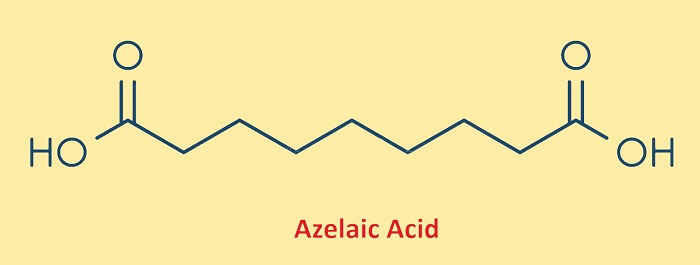Azelaic AcidAzalaic acid is also called 1,9-nonanedioate, AZA or azelex. It is a 9 carbon dicarboxylic acid that occurs naturally in whole grain cereals, barley, rye and is also produced by Malassezia furfur, a species of fungi, which is generally found on the skin of humans. On a large scale, it is prepared by the ozonolysis of oleic acid. It has antibacterial, keratolytic, comedolytic and anti-oxidant properties. Owing to these properties, it is used in the treatment of various skin conditions such as acne and rosacea. Chemical StructureIts chemical formula is C9H16O4. It shows that it is made of 9 carbon atoms, 16 hydrogen atoms and 4 atoms of oxygen. 
Properties of Azelaic Acid
How does azelaic acid benefit the skin?It removes bacteria from skin pores, which may be causing irritation. It also reduces inflammation which makes acne less visible and less red. Further, it promotes cell turnover that allows your skin to heal quickly and thus also minimizes scars. AvailabilityAzelaic acid is available in the form of gel, foam and cream. All types are used in a similar way as described below:
Uses of Azelaic Acid
Further, in plants, it acts as a distress flare as it plays a role in the defence response after an infection in a plant. For example, it stimulates the accumulation of salicylic acid, which is an important part of a plant's defence mechanism against infection. Mechanism of ActionThe accurate mechanism of action of this acid is not known. It is believed that its antibacterial properties are owing to its ability to inhibit the synthesis of cellular protein in aerobic and anaerobic bacteria. In aerobic bacteria, it reversibly prevents various oxidoreductive enzymes. Whereas, in the case of anaerobic bacteria, it inhibits glycolysis. Azelaic acid is mostly excreted unchanged in the urine, but it undergoes some ß-oxidation to short-chain dicarboxylic acids. Some brand names of azelaic acid are Azelex, Finevin and Finacea. Azelaic Acid Side Effects and PrecautionsThe common side effects are as follows:
The less common side effects are fever, difficulty breathing, blistering, hives, pain in the joints, loss of appetite, constipation, change in taste, nausea, diarrhoea, etc.
Next TopicGlycolic Acid
|
 For Videos Join Our Youtube Channel: Join Now
For Videos Join Our Youtube Channel: Join Now
Feedback
- Send your Feedback to [email protected]
Help Others, Please Share










